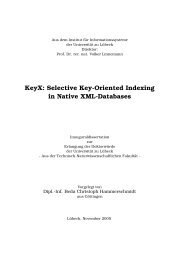Biochemische Charakterisierung der siRNA-vermittelten Erkennung ...
Biochemische Charakterisierung der siRNA-vermittelten Erkennung ...
Biochemische Charakterisierung der siRNA-vermittelten Erkennung ...
Erfolgreiche ePaper selbst erstellen
Machen Sie aus Ihren PDF Publikationen ein blätterbares Flipbook mit unserer einzigartigen Google optimierten e-Paper Software.
Summary<br />
RNA interference (RNAi) is a highly specic mechanism to control gene expression on the<br />
posttranscriptional level. It is found in all higher organisms including humans and comprises<br />
the sequence-dependent recognition and binding of a target mRNA by the ribonucleoprotein<br />
complex RNA-induced silencing complex (RISC). Consequently, mRNA translation is blocked<br />
either by endonucleolytic cleavage or by steric hin<strong>der</strong>ing of the translation machinery. The<br />
Argonaute2 protein (hAgo2) is the key component of human RISC and associates with a<br />
ribonucleic acid portion, the guide RNA. The enzyme is composed of four domains, namely<br />
the N-terminal, PAZ, Mid and PIWI domains. Its ability to bind any given guide RNA makes<br />
it a universal molecular tool of cells. The aim of this PhD thesis was the biochemical and<br />
kinetic characterisation of recombinant hAgo2 in vitro.<br />
The initial goal was to obtain sucient amounts of enzymatically active recombinant hAgo2.<br />
Therefore, ve dierent strategies for the expression and purication were established and<br />
tested in parallel. Poor solubility and incomplete translation of the fusion proteins were the<br />
major problems encountered. Nevertheless, the isolation of hAgo2 bearing an N-terminal GSTtag<br />
un<strong>der</strong> non-denaturing conditions could be achieved. The protein was puried in milligram<br />
amounts and showed high enzymatic activity. All tested constructs were able to cleave target<br />
RNA in a characteristic, sequence-specic manner, whereas a C-terminally modied construct<br />
exhibited a drastic decrease in turnover as compared to proteins with non-modied C-termini.<br />
This suggests that the tag disrupts the correct protein folding and emphasizes similarities<br />
between the domain structures within prokaryotic and eukaryotic Ago proteins. Furthermore,<br />
insight concerning the optimal Mg 2+ concentration for the cleavage of target RNA as well<br />
as the oligomerisation behaviour of hAgo2 could be gained. hAgo2 was found to possess the<br />
tendency to aggregate, which can be induced by high temperature. This process can almost<br />
completely be abrogated by the addition of RNA.<br />
The main focus of this thesis was the biochemical and kinetic characterisation of the <strong>siRNA</strong>mediated<br />
target RNA cleavage by recombinant hAgo2. The process could be broken down into<br />
four steps (loading of hAgo2 with an <strong>siRNA</strong>, target RNA recognition and binding, its cleavage<br />
and release of the cleaved products). Consequently, these four steps were investigated individually<br />
by performing appropriate experiments. In a rst set of experiments, hAgo2 loading<br />
was analysed. For this matter, a uorescence-based system was developed and used to observe<br />
the binding reaction of hAgo2 with single- and double-stranded <strong>siRNA</strong> un<strong>der</strong> steady and<br />
pre-steady state conditions. It could be shown for the rst time, that recombinant hAgo2 is<br />
3
















